How to Find Your Goldilocks Keywords With Search Intent Analysis
Topic: Guest Experts
Published:
Written by: Brandon Leuangpaseuth
When it comes to SEO strategy, optimizing for search intent is more important than going after keyword search volumes.
This can seem counterintuitive to what you’ve been taught in the past about SEO, but targeting search intent correctly is what can produce the most meaningful results long-term.
In fact, focusing on optimizing for keywords and search volumes alone is a slightly outdated organic digital marketing practice—but if you’re landed here, you likely know that already.
In this article, I’ll show you how to analyze search intent sharply—that way, you’ll have clarity to:
Find your perfect Goldilocks keywords that fit just right
Create the right type of content for your target keywords
Offer the best user experience for your target audience
Protect your organic search visibility by reducing bounce rates
Develop content that increases conversion rates
I’m assuming you’re already familiar with what search intent is (also called user intent). But if you need a refresher, check out our What is user intent guide.
LEARN MORE: Why is search intent important? Check out How to optimize for search intent to learn how to earn better rankings and more conversions.
How to analyze the SERP in 5 easy steps
The Google SERP (or Search Engine Results Page) will give you plenty of information about what search engines understand as the true user search intent behind a query.
Here’s how you analyze that information step by step, so you can use it to your advantage.
Step 1: Google the keyword and review the SERP
The first step is to type the target keyword onto the search bar of Google.
Simple enough, right?
The SERP results will display the best information to meet the user’s search intent.
Let’s look at an example together with the keyword [intermittent fasting]. This particular search query falls under informational intent.
READ MORE: Are there more than 4 types of search intent? You bet. Go beyond the basics in our guide to the expanded types of search intent.
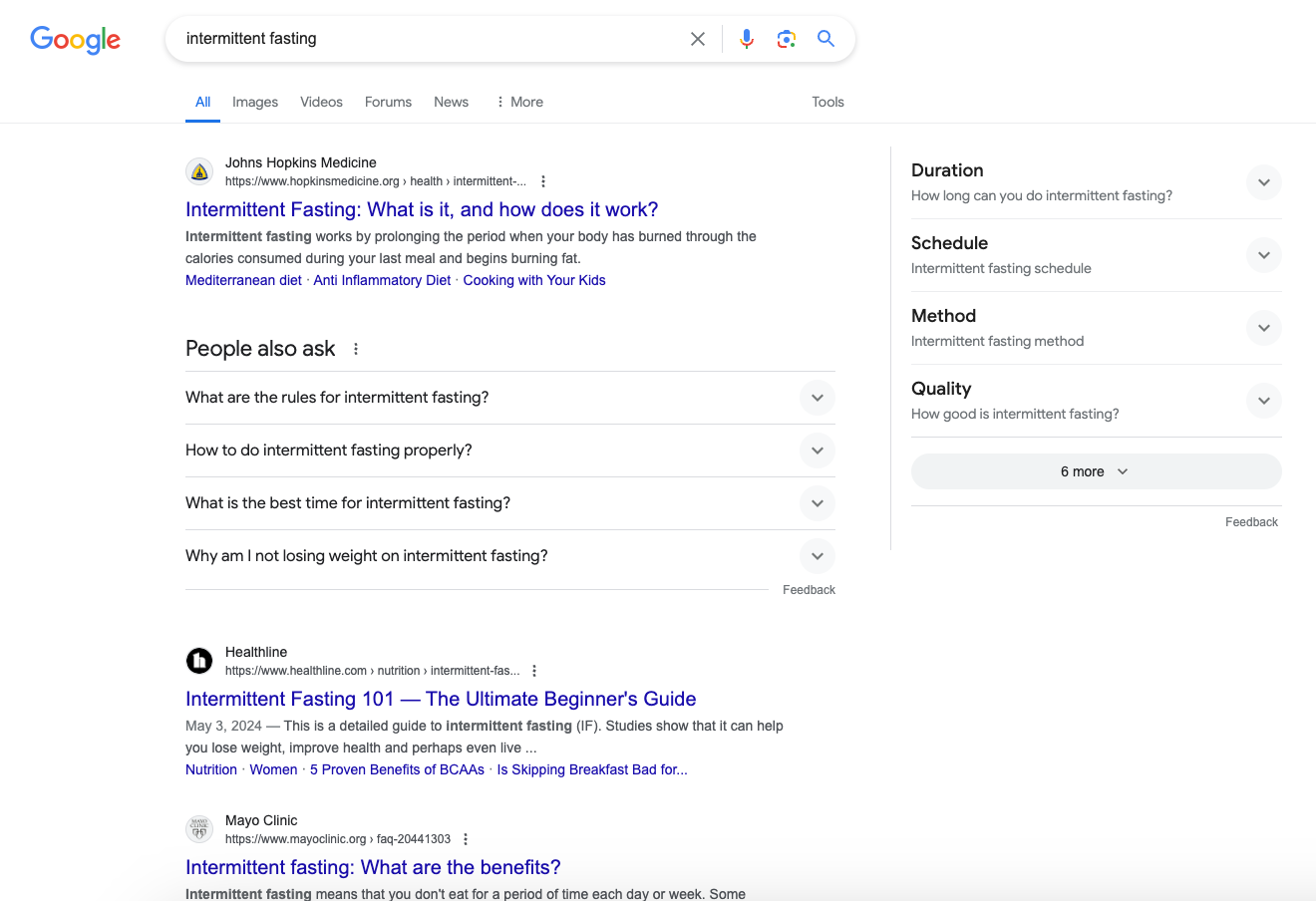
Google search results for [intermittent fasting].
Take a look at the type of intents Google reveals in the above results page. People are wondering:
How long should you do intermittent fasting
Schedules for intermittent fasting
What are the rules
How to do it properly
If it’s good or not
Note here: You don’t see Google Search providing any results that would resolve a navigational intent or commercial intent for this informational search. That would be… a poor user experience, to say the least.
So keep that in mind. If you’re targeting this keyword in particular, you’d want to create informational content to resolve an informational search intent.
For example, an e-commerce page would not meet the keyword intent and would harm your chance of ranking here.
Instead, you could produce an article series that includes interviews with a dietician, physician, and an athlete who does intermittent fasting to offer different authoritative perspectives.
Step 2: Make a note of the types of search intent categories on the first page
Scan each top-ranking page and note the search intent (or user intent) category the result falls under.
Next, examine the top results to determine the searcher’s intent for the keyword.
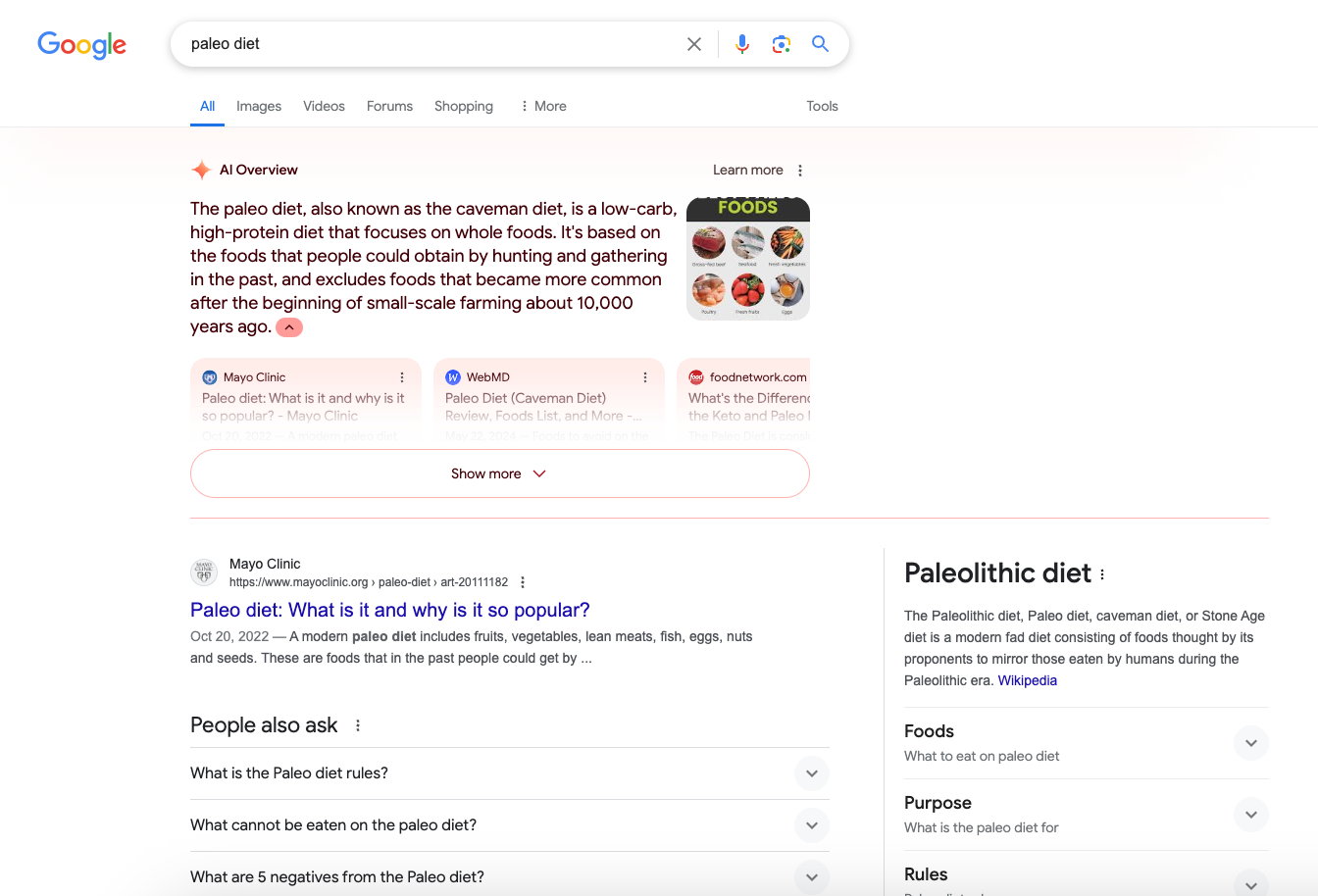
This Google search result for [paleo diet] offers a variety of rich results, including a Google AI Overview on the topic.
Scan the SERP to get a good clue of what type of intent the search query is.
For example, in this search for [paleo diet], you can tell by the results that the user is looking for.
They are searching for:
A succinct definition or description of the diet (hence the AI Overviews result)
More information about how to do the diet
What foods can and cannot be eaten
Reviews and rules for trying the diet
After examination of these results, if you were targeting this particular keyword, you could write a piece of content that offers a first-person perspective on following the diet for three months and shares links to favorite paleo recipes.
Bonus tip: At this stage in your search intent analysis, paying attention to keyword modifiers can help you infer additional information about true search intent and inform the type of content you create.
As a refresher, here’s a list of modifiers that can indicate a certain type of search intent:
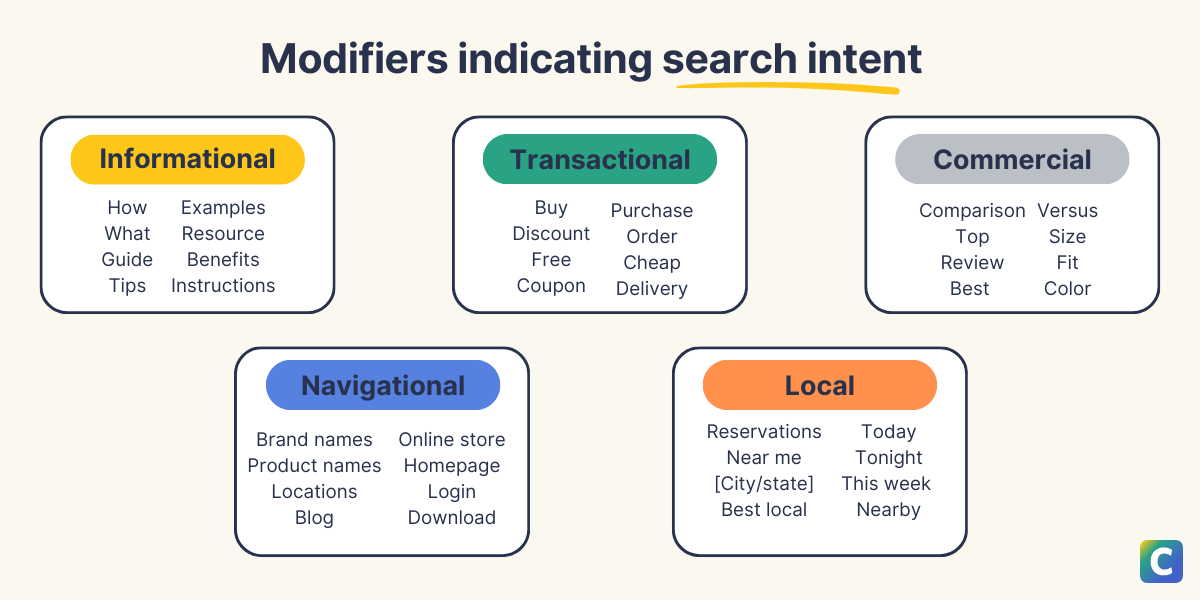
Informational query modifiers
how
what
who
what
why
guide
tutorial
tips
examples
resource
benefits
Instructions
Modifiers for navigational queries
Specific brand names
Brand product pages
Service names
Locations
Go
Query modifiers that signal commercial investigation
best
top
review
comparison or versus
an attribute of a product (color or size)
Modifiers for transactional queries
Buy
Discount
Free shipping
Coupon
Purchase
Order
Cheap
Price
Order
Delivery
Local query modifiers
Reservations
Near me
[City/state]
Best local
Today
Tonight
This week
Nearby
Delivered today
Step 3: Analyze the SERP features and featured snippets
Next, you’ll scan the SERP features to further dig into search intent—paying attention to what kind of content marketing best serves your target audience and targeted query.
You’re probably already aware, but as a refresher: Google’s algorithms are designed, in theory, to provide the most high-quality information possible to meet user intent.
Here are a few examples of how Google does that and what you can look for when you’re analyzing search intent:
For the query [chocolate chip cookies], Google provides top-rated recipes first rather than an Amazon listing to order and ship them premade, demonstrating informational intent rather than commercial search intent or transactional intent.
For the query [how to change your air filter], Google provides a how-to video tutorial first, followed by step-by-step how-to articles, making it clear that video content and articles with visuals are what users prefer for this informational query.
For the query [pay my electric bill online], the Google algorithm is smart enough to provide me with the online bill pay page for my local electric company, showing a local transactional search intent.
For the query [shaquille oneal instagram], Google understands that the user is looking for a social media account on a particular platform, indicating a navigational search intent.
The People Also Ask section and AI Overviews are also handy tools to discover search intent data.
Below, I’ll explain why each of these sections are valuable to understand the type of search intent behind a query.
How Google generates the People Also Ask section
This section is auto-generated by Google. Google suggests queries based on its user's search history database.
Based on the information in Google’s database, it would suggest other phrases or questions that users would subsequently type into the search engine to finish their search journey.
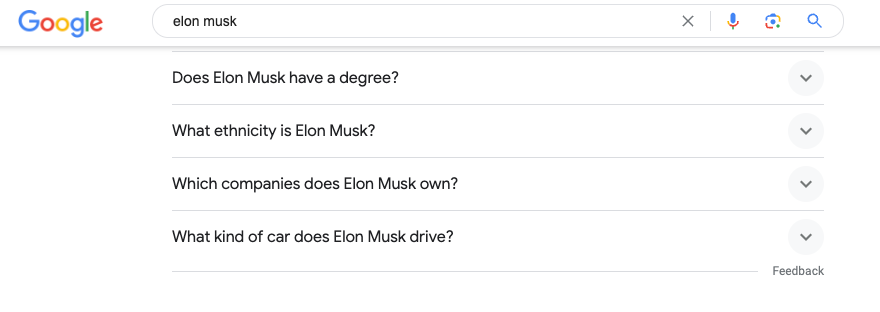
The Google search result for [elon musk] shows additional questions users are likely to ask.
For example, for the search query [elon musk], users who searched this phrase in the recent past would type these additional queries into Google afterward to conclude their search journey.
What does that mean for your content strategy? Well, the People Also Ask section can highlight opportunities to better meet search intent or create content for less competitive or long-tail keywords.
Let’s say you run a site that sells specialty bikes across the United States.
For the query [adult tricycle], people ask if they are harder to ride, what they’re called, how stable they are, and—well—why adults ride tricycles.
In addition to targeting the commercial intent behind the parent query on product pages, you can create supportive, interesting educational content for those in your target audience who aren’t quite ready to buy yet and need “informational keyword” questions answered before they make a purchase.

A search for [adult tricycle] reveals plenty of questions to create content around.
What Google’s AI Overviews can tell you about search intent
When an AI Overview is displayed in the SERP for a person’s query, it’s usually a clear indication that the user needs a short, straight forward answer for simple what, where, why, and how questions.
Let’s get meta for a moment, here’s the AI Overviews result for [what is user intent].

Google AI Overviews results for [what is user intent].
If the searcher needs additional information after the AI Overview or has more extensive questions, that’s where your content can come in handy—which is one of the many reasons why adding information gain, originality, and fresh perspectives to your content is essential.
Step 4: Check Google's auto-suggest feature
Like the People Also Ask section, Google's auto-suggest feature is also auto-generated.
It's created based on what users later search for after the initial query to end their search journey.
The auto-suggest feature can provide valuable insights into what content to build.

Google search for [Garcinia Cambogia].
In this example, users would finish their search journey after discovering content about:
The benefits
The side effects
Reddit discussions about the supplement
Places to purchase it
Again, this information is made from Google’s extensive user database—they are monitoring all those metrics continuously, after all.
Leverage this data from manual searches to curate content that satisfies search intent.
Step 5: Develop a game plan to satisfy the search intent
Once you determine the search intent, it’s time to develop a game plan to rank.
Ask yourself, How could I help the user solve this problem in the most helpful way possible?
After you scan the top results—including SERP features like video carousels, AI Overviews, Featured Snippets, and People Also Ask questions if they appear—locate holes in topics covered or areas of improvement for existing ranking results.
For instance, let's say you are writing an article that’s targeting the query [find a freight forwarder]. The content will target individuals who import materials or products from abroad.
You may notice all the top results are rehashing generic advice, i.e. “search up best freight forwarder on google” or “use freight forwarding directories.”
Instead, you could add information gain and originality to the topic with the content you produce by interviewing an expert in freight forwarding or imports. Expert insights could include actionable advice on how to find a freight forwarder.
Clearscope’s Keyword Discovery feature can help you analyze search intent
When applying your research and trusted marketing strategies across your content to sharply meet search intent, it’s important to not focus so much on automatic intent labels of keywords (e.g., informational, navigational, transactional, and commercial).
Traditional tools like Semrush and Ahrefs bucket keywords into different search intents, which can be a helpful start.
But you’ll still need to dig into how to target search intents overall in your content: What kind of content is Google serving to resolve the searcher’s need?
That way, you’re always optimizing for intent and not just SEO keywords.
Clearscope's content-first SEO platform has a Keyword Discovery feature that isn’t your standard keyword research tool.
The Keyword Discovery tool includes keyword difficulty and estimated traffic, which will feel fairly familiar to other tools you’ve used in the past. But Clearscope considers Google's auto-suggest features and generates phrase suggestions that match a keyword's search intent.

When performing keyword research in Clearscope, you'd be able to:
Analyze the keyword results for a specific web page
Map intent to specific keywords (watch our webinar to learn how)
Determine relevant content to create based on traffic estimates
Let's run "freight forwarder" through Clearscope’s Keyword Discovery tool.
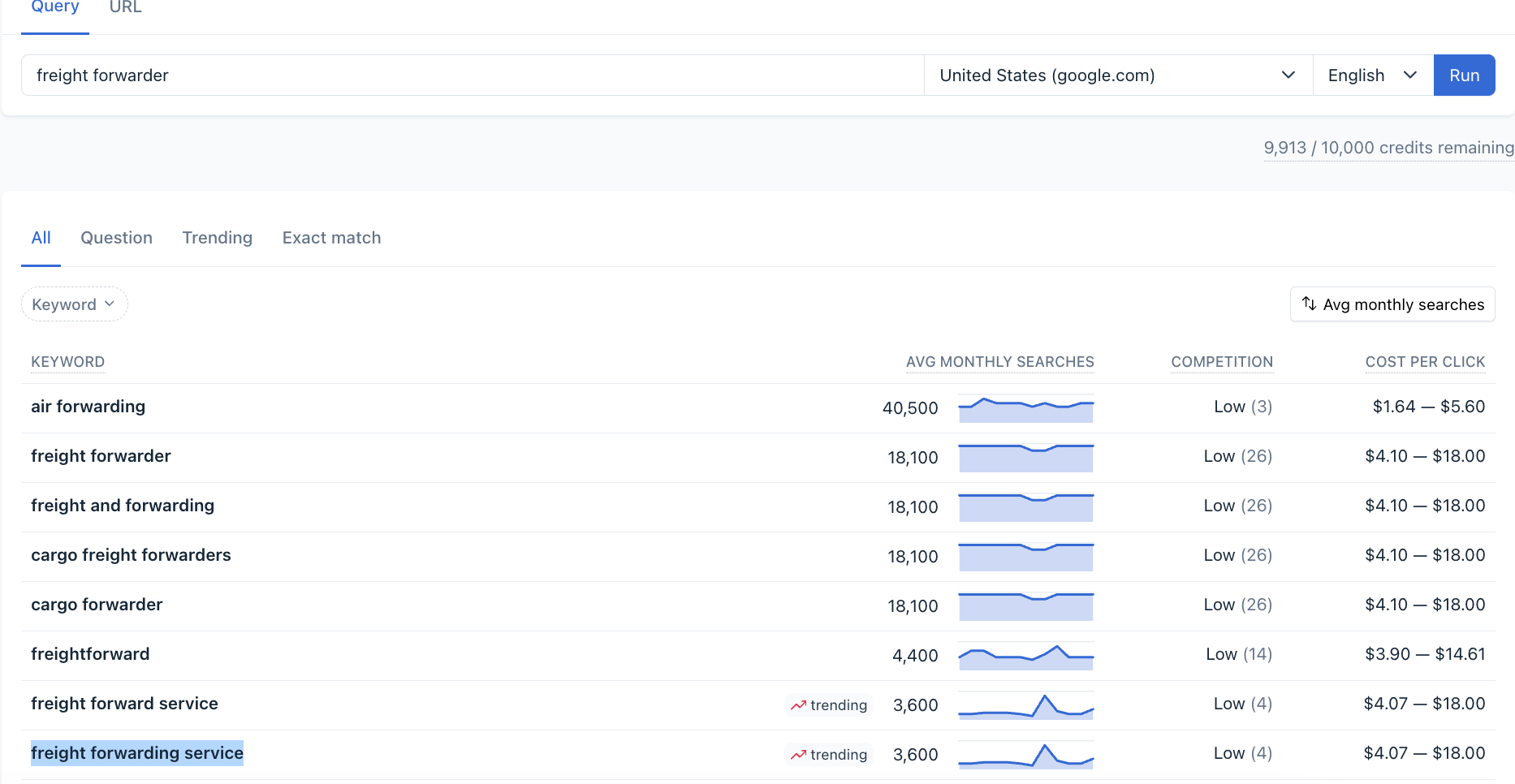
Targeting the intent behind “freight forwarding services” looks like a solid option because:
There is a nice trending average monthly search volume
You’d be able to group the keyword with other ones which have similar intent (freight forwarder companies, international freight forwarder)
By performing keyword research and aligning the search intent, you’ll give your content the best chance to rank well on Google.
Now, that’s some seriously good search engine optimization!
Note: Try Clearscope’s Keyword Discovery tool to create content that satisfies a keyword’s search intent.
Search intent analysis isn’t a one-and-done task
Once you’re on Page 1 of Google, staying on Page 1 for search terms is not set in stone. Even if you’re producing the highest quality content possible.
When you analyze the SERP, you are judging search intent based on a single moment in time. And the search intent behind a keyword can change.
If you typed in a keyword today and checked the search results a few months later, Google's understanding of the search intent could change.
For instance, let’s consider the keyword [bulletproof coffee].
When bulletproof coffee was first introduced, many people didn't know what it was. They would search on Google to better understand bulletproof coffee.
As more people became familiar with bulletproof coffee, the search results changed to match the new search intent.
Users were now wondering if bulletproof coffee was dangerous, how to make it, the pros and cons of bulletproof coffee, and weight loss case studies by using it.
So naturally, the search results began to reflect the new search intent data.
Pages that used to rank on the first page of Google with information about bulletproof coffee no longer ranked as high as the search intent changed. Landing pages that marketed specific products popped up as it became more popular—and there’s now a specific website under that brand name that sells bulletproof collagen products
A high-quality page about "what is bulletproof coffee" no longer satisfied the search intent for the keyword. People eventually were looking to buy—and informational and commercial searches have different intents, of course.
So keep this in mind: Staying up to date and matching search intent behind keywords is crucial to staying at the top of the rankings.
When optimizing for new pieces and when refreshing existing content, always check the results on Google for the specific search query to see the new intent direction or trends.
Ready to do search intent optimization correctly?
Now that you have a better understanding of how to analyze search intent, you’re ready to optimize your content to create the best experience possible, all while reducing bounce rate and increasing engagement.
(You know, all those good Google Analytics metrics everyone loves to see.)
Check out How to Optimize for Search Intent to continue learning how the experts do it.
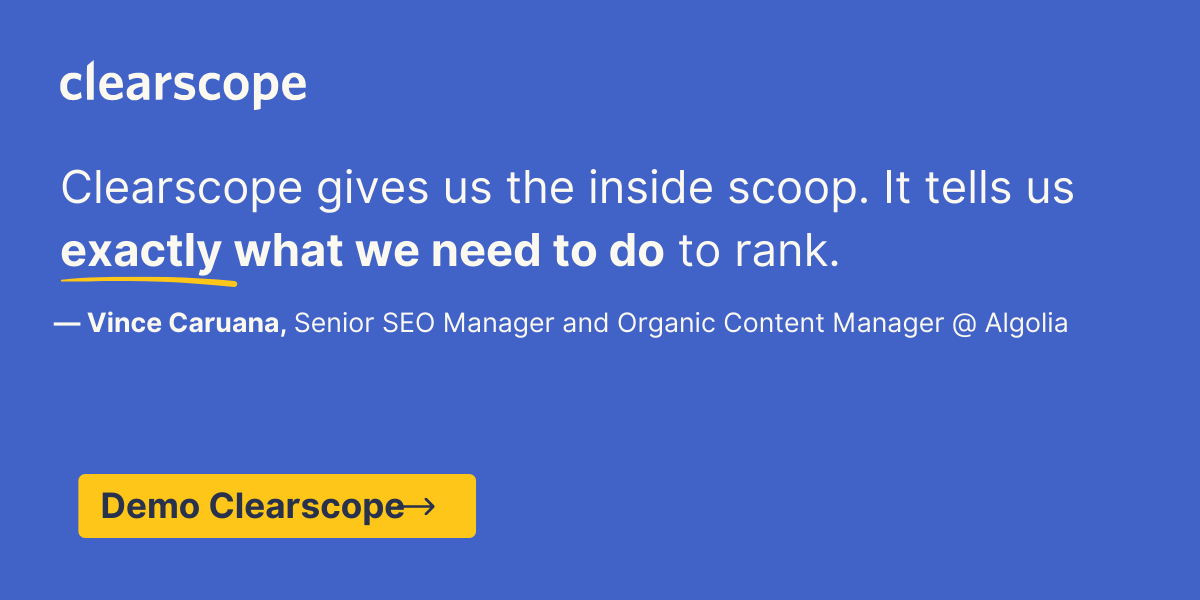
Contributing authors and updates
The original version of this article was published June 10, 2022, by guest contributor Brandon Leuangpaseuth. It was updated June 25, 2024, to include updated education on current best practices by the Clearscope team.
How to Create the Perfect SEO Content Brief in the Era of Ai-Assisted Content
Discover how to craft SEO content briefs that focus on people-first content, even in the AI era. Learn to streamline content production and boost organic traffic with actionable, user-centered strategies.
Read moreTopic Clusters: What Are They? Do They Help Your SEO? (with Video)
Learn how to implement a topic cluster strategy with our step-by-step guide plus a video.
Read more7 On-Page Optimization Tools to Create & Update Site Content
Our guide compares the best on-page optimization tools to research keywords, write SEO-optimized content, and improve rankings in Google search results.
Read more